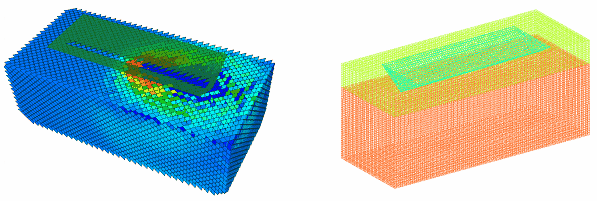
Summary
The ditching of an object into a pool of water is studied using SPH and ALE approaches. The simulation results are compared to the experimental data and to the analytical results. Furthermore, the study is performed using different impact velocities. The object is modeled using a triangular section. In the first approach, a SPH model is used for water. This example deals with the problem of an interface definition between the two parts. First, the SPH boundary and type 7 interface are used. Moreover, the object undergoes a linear elastic law; the water being defined by the hydrodynamic viscous fluid law 6. The results are compared with regard to the pressure and acceleration outputs. The OUTLET boundary conditions provide appropriate results. In the second approach, the water is modeled with an ALE mesh while the structure is Lagrangian. The interface type 18 is used to treat the fluid-structure interactions. The results compared to Von Karman theory, illustrate the robustness and stability of the ALE method.
Here RADIOSS Multi-Domain applied to Fluid Structure Interaction (FSI) is demonstrated, which is easy to define Multi-Domain with Single Input Format. Highly effective computation speedup and results are equivalence whatever H-MPP setup.
See Also:
Ditching using SPH (Mono-Domain) (No. 22.1)
Ditching using ALE (Mono-Domain) (No. 22.2)
Ditching using Multi-Domain for SPH and ALE (No. 22.3)









